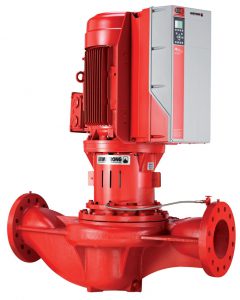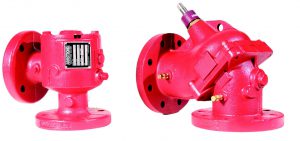 As Seen on WorldPumps – September, 2016
As Seen on WorldPumps – September, 2016
When a major commercial building in the centre of Birmingham needed to refurbish the site’s HVAC pumping system, Armstrong Fluid Technology came up with an alternative solution which reduced energy consumption and improved efficiency.
The Axis office complex occupies a 178,000 sq. ft site close to Broad Street and Birmingham New Street Station. The 11-storey building has recently undergone a major HVAC refurbishment and Armstrong Fluid Technology was asked to provide a proposal for the project. The existing pumps, which were fixed speed end suction models, were reaching the end of their useful life.
Armstrong was asked to suggest an alternative which would reduce energy consumption, improve efficiency, and enhance the building's sustainability. It was also important that the project involved minimal adaptation of pipework, and the new pumps could be installed within a similar physical footprint to the current ones.
 Armstrong’s team compared a number of different technical scenarios, quantifying potential benefits, and recommended a solution which was able to meet the project’s requirements. The pumps, which are now installed at The Axis, are Armstrong 4300 Series Design Envelope IVS variable speed models which optimize the energy efficiency of the system automatically, across a wide range of operational conditions.
Armstrong’s team compared a number of different technical scenarios, quantifying potential benefits, and recommended a solution which was able to meet the project’s requirements. The pumps, which are now installed at The Axis, are Armstrong 4300 Series Design Envelope IVS variable speed models which optimize the energy efficiency of the system automatically, across a wide range of operational conditions.
Optimizing energy efficiency
Employing demand-based control technology, the Armstrong pumps significantly reduce utility bills and, long-term, will improve the building’s environmental performance. In addition, the retrofitted pumps are capable of increasing energy efficiency across a wider operating profile than other pump ranges, offering the building’s owners the best possible environmental performance irrespective of changes in tenancy and occupation levels.
Armstrong 4300 Design Envelope pumps are used with heating and cooling systems, and include a Vertical In-Line pump, motor, and Intelligent Variable Speed controller. They reduce pumping costs through variable speed, demand based operation — consuming only the energy required, based on current system demand. The variable speed intelligence embedded in the controller enables the pump to respond instantaneously and automatically to system load, adjusting the speed of the pump and drawing only the power required to meet that load.
Further savings
The pump accessories specified for The Axis deliver further project savings by reducing installation times. Armstrong Suction Guides and Flo-Trex valves reduce the requirement for pipework and fittings, and perform multiple functions with a single component. This speeds up installation and reduces cost while offering a valuable reduction in physical footprint. The resulting space reduction and the vertical in-line design of the 4300 Series, enabled the pumps at The Axis to be retrofitted within a similar footprint, with much of the original pipework retained.
Throughout their lifecycle, the pumps will also reduce maintenance costs for the building’s owners. They feature a split-coupled design which enables seals to be replaced in situ, without removing the pump or motor. This enables seal changes to be carried out in hours rather than days, without the need for specialist lifting equipment.
 Future proofing
Future proofing
The pumps are designed using Armstrong’s Design Envelope concept and offer outstanding energy efficiency capabilities which continue to be optimized even if operational requirements of the building vary. This built-in safety net eradicates the need to trade-off the energy efficiency of the installation through oversizing of equipment. It also futureproofs the building by providing more flexibility over time without the need for costly HVAC refurbishment. The efficiency of the pump motors is also well ahead of the incoming 2017 legislation which, in combination with in-built variable speed intelligence, enables the pumps to deliver energy savings of up to 70%.
David Roper, Area Sales Manager at Armstrong Fluid Technology, commented, “The Armstrong 4300 pumps are an extremely effective and reliable choice for commercial buildings like this, and the extra flexibility provided by the Design Envelope design concept provides additional peace of mind for the building owners and occupiers.”



